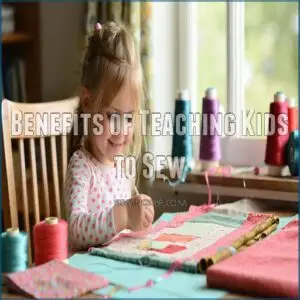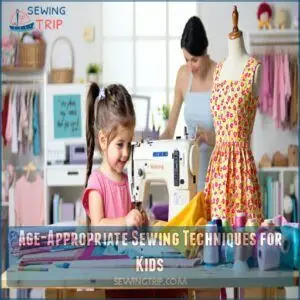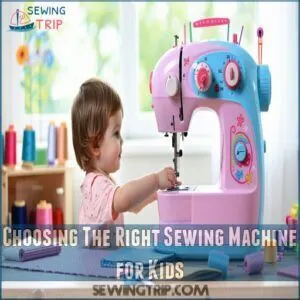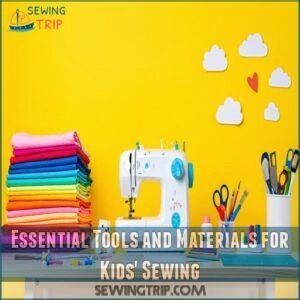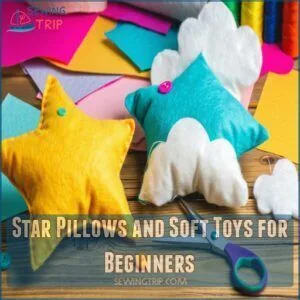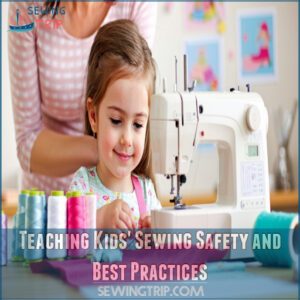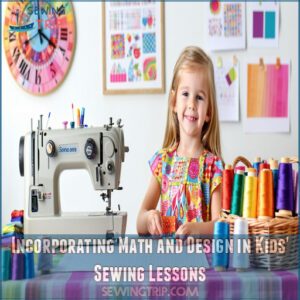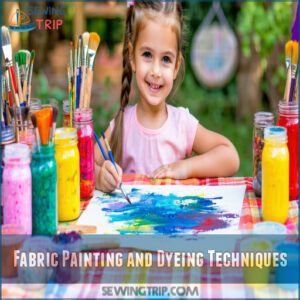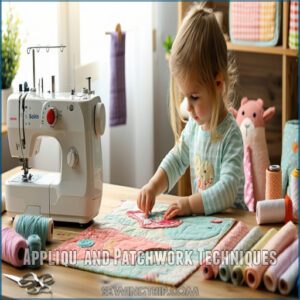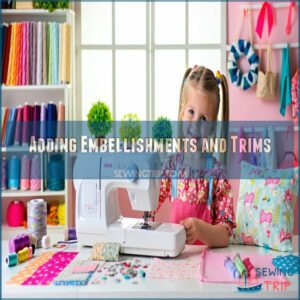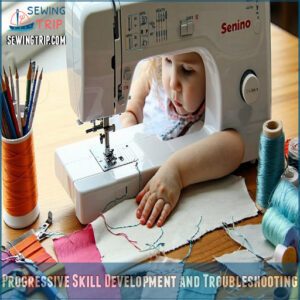This site is supported by our readers. We may earn a commission, at no cost to you, if you purchase through links.
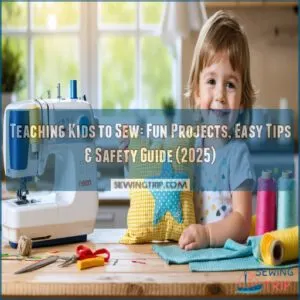
Start with kid-friendly scissors and needles, then let them explore colorful fabrics that spark joy.
Teaching kids to sew isn’t just about stitching; it’s about building confidence, developing patience, and watching their creativity soar.
Let them choose projects that excite them, from simple pillows to funky scrunchies.
Keep the atmosphere light and celebrate every wonky stitch – those "happy accidents" often turn into the most cherished creations.
With the right tools and guidance, your little craftster will soon be threading needles like a pro.
Table Of Contents
- Key Takeaways
- Benefits of Teaching Kids to Sew
- Age-Appropriate Sewing Techniques for Kids
- Choosing The Right Sewing Machine for Kids
- Essential Tools and Materials for Kids’ Sewing
- Fun and Easy Sewing Projects for Kids
- Teaching Kids’ Sewing Safety and Best Practices
- Incorporating Math and Design in Kids’ Sewing Lessons
- Encouraging Creativity and Customization in Kids’ Sewing
- Progressive Skill Development and Troubleshooting
- Frequently Asked Questions (FAQs)
- Conclusion
Key Takeaways
- Teaching kids to sew boosts fine motor skills while fostering patience and problem-solving, and it also boosts creativity and confidence.
- Start with simple, age-appropriate projects like scrunchies or pillows, using kid-friendly tools and colorful fabrics.
- Focus on safety by introducing blunt needles, rounded-tip scissors, and sewing machines with guards and slow speed settings.
- Celebrate progress, encourage customization, and make learning fun with projects that let kids explore their imagination.
Benefits of Teaching Kids to Sew
Teaching kids to sew has so many benefits.
They’ll gain confidence and creativity while developing essential fine motor skills and hand-eye coordination.
It’s a fun way to encourage patience, perseverance, and a sense of satisfaction as they create their own unique projects.
Building Confidence and Creativity
Teaching your kids to sew gives them a fun outlet for self-expression and creativity.
It sparks their imagination and lets them explore artistic possibilities.
Sewing is a proven anxiety-buster, triggering a relaxation response that keeps depression at bay.
Just watch their faces light up with pride as they show off their unique creations.
Each stitch becomes a step in their dance of problem-solving, boosting their confidence and sense of achievement.
Nurture their creative freedom with sewing tutorials that offer playful patterns and easy tips.
Soon, they’ll be sewing maestros, expressing themselves through fabric and thread.
Sewing inspiration equals confidence boosters!
Developing Fine Motor Skills and Hand-Eye Coordination
Sewing’s not just fun and games—it’s a sneaky way to boost your kid’s fine motor control and hand-eye synchronization.
Each project is a dexterity exercise, a coordination drill, and a lesson in motor skill development.
Imagine your child, a fabric-wrangling pro, nailing needle control and stitch consistency.
Sewing teaches:
- Fine Motor Control
- Hand-Eye Synchronization
- Dexterity and Coordination
So, get ready to watch your child’s skills (and confidence!) soar with improved hand-eye synchronization and dexterity.
Encouraging Patience and Perseverance
Oops!" moments are a normal part of sewing and life.
Instead of getting frustrated, use these moments as opportunities to teach patience and perseverance.
Celebrate small wins and provide positive reinforcement to keep them motivated.
Set achievable goals to help them develop resilience and a growth mindset.
With your gentle guidance, they’ll learn that patience is a virtue, and they’ll develop the focus to overcome challenges and keep practicing.
By focusing on skill building techniques, you can help your kids develop a strong foundation in sewing and build their confidence over time.
Fostering Joy and Satisfaction
There’s a special magic in teaching kids to sew – it’s about so much more than stitches and fabric.
It’s a journey of creative freedom and joyful learning, where kids discover a world of self-expression and build skills for life.
That spark of pride and happiness when they bring their unique creations to life is priceless!
You’re fostering:
- A fun, encouraging space to explore and create
- A mindful sewing practice, focusing on the process
- The joy of making, with a dash of student engagement
- Bonding through shared projects and happy crafting
- Skills that extend beyond the sewing room
Age-Appropriate Sewing Techniques for Kids
Teaching sewing to kids should be adapted to their age and skill level.
We’ll guide you through hand-sewing basics for younger kids and simple machine skills for older ones, with fun projects to match.
Hand Sewing Basics for Younger Kids
Hand sewing is all about releasing creativity with simple stitches.
It’s a fun way for kids to start sewing and create cool projects.
But before they start, needle safety is key.
Choose sharp, rounded-tip scissors and sharp needles for their sewing kit.
Introducing them to teaching kids concepts that make sewing enjoyable and easy to learn is necessary.
Selecting kid-friendly fabrics like felt for these beginner projects is vital for building confidence with basic stitches and lets their imagination run wild.
It’s like unraveling a mystery, where each hand stitch tells a unique part of the story!
| Sewing Notion | Why It’s Great for Kids |
|---|---|
| Felt | Easy to work with, doesn’t fray, and comes in fun colors. |
| Cotton Fabric | Soft and comfortable to work with. |
| Chenille Needles | Large eye for easy threading. |
| Kid-Friendly Scissors | Rounded tips for safety. |
| Ordinary Cotton Thread | Ties together to stay on the needle. |
Simple Machine Sewing Skills for Older Kids
Buttonholes might seem like a beast, but older kids can tackle ’em with patience and the right sewing machine skills.
Start with straight stitching and mastering that pedal control—it’s like driving a car, but with thread.
Keep things fun and safe with a machine that has the right features and safety practices.
Unraveling joy is no fun, so keep those accidents at bay.
Age-Specific Sewing Projects and Activities
Stepping stones to creativity, sewing projects suited to kids’ ages spark their interest and build skills.
Check out these fun ideas:
- Ages 5 to 7: Hand-sew stuffed animals, a fun way to master basics.
- Ages 8 to 10: Drawstring bags introduce machine sewing without overwhelm.
- Ages 11 to 13: Simple skirts offer a stylish twist, boosting design confidence.
- Teens: Customized tees let their unique style shine through.
Safety always comes first when crafting these creations!
Choosing The Right Sewing Machine for Kids
When choosing a sewing machine for your child, safety features should be your top priority. Look for machines with speed control and a shut-off function to prevent accidents.
Safety Features to Look for in a Sewing Machine
Picking the right sewing machine is like choosing a trusty sidekick.
Look for sewing machines for children with Machine Guards and Needle Protection, like finger guards, to keep little fingers safe. Adjustable speed controls and Safety Sensors help kids manage the pace.
Automatic Shut-off and Emergency Stops add an extra layer of sewing machine safety. A jam-proof bobbin and an automatic needle threader smooth out sewing machine usage, making troubleshooting and maintenance a breeze.
When selecting a machine, consider consulting a guide on the best sewing machine for kids to make certain you find the perfect fit. With these features, your sewing adventures will be smooth sailing!
Ease of Use and Customization Options
Keep it simple, keep it fun" is the motto when choosing a sewing machine for your kid.
Look for a model that strikes a balance: safe and easy to use, but with customizable options to keep projects exciting.
Here’s what to take into account:
- Adaptable Features: Go for adjustable needle types and user-friendly controls. These features let your child experiment with different stitch selections and grow their skills.
- Compact Design: A smaller machine is less intimidating and easier to manage for small hands.
- User Interface: Look for a model with a clear and intuitive display.
- Custom Threads and Sewing Apps: Explore machines that offer a variety of built-in stitches and patterns, or those compatible with sewing apps, to expand fabric choices and machine settings.
When selecting a sewing machine, consider Sewing Machine Kids options that cater to their skill level and interests.
Styrofoam Practice and Tapestry Needles for Beginners
Want to boost your needle control before working with fabric?
Grab some Styrofoam blocks and tapestry needles—it’s Foam Sewing 101!
Tracing patterns onto the foam is like a test run for your sewing machine.
This gets you comfy with tapestry basics and builds confidence for teaching kids to sew.
Kids sewing lessons using this Styrofoam safety method are great beginner tips, especially for beginner sewing and sewing for kids, making sewing basics fun and easy!
Essential Tools and Materials for Kids’ Sewing
You’ll need the right tools to start your sewing adventure, so let’s gather some fun and kid-friendly supplies.
Think colorful fabrics, easy-to-handle needles, and safety scissors – we’ll cover everything you need to get started.
Kid-Friendly Scissors and Needles
Amidst the joys of sewing, a nick from a needle or snip with scissors can quickly turn fun into tears.
So, choosing kid-friendly tools is key, to prevent such accidents and ensure a safe sewing experience for children.
Go for blunt tip needles with large eyes, making it easier for tiny hands to thread, and pair with scissors featuring safety handles, ergonomic grips, and rounded tips.
Childproof blades guarantee cuts are fabric-only, which is a crucial aspect of child safety when it comes to sewing tools.
With these tools, you’ll keep creativity high and boo-boos low, making the sewing experience enjoyable for kids.
When selecting the right scissors, consider kid friendly options that cater to small hands and safety needs.
Beginner-Friendly Fabrics and Notions
Let’s get stitching! For beginner sewing projects, you want fabrics that are friendly, like a supportive pal.
Cotton’s a great choice—easy to handle and perfect for training. Bright threads and simple patterns on projects like star pillows or scrunchies will have ’em excited.
Let your kiddos explore and create. It’s all about building their confidence with these newfound sewing skills.
So, go ahead and grab some kid-friendly fabrics and let the fun begin, focusing on sewing skills that will last.
Measuring and Marking Tools for Kids
Three essential sewing tools for kids include kid-safe scissors, fabric markers, and measuring tapes.
Introduce ruler basics and fabric rulers early, for they are fundamental to the sewing process.
For accurate seam allowances and pattern placement, sewing gauges are your best friends, and don’t forget marking tools and pattern weights.
These sewing basics help transform kids sewing kits into creative powerhouses, so grab a measuring tape and get started!
Fun and Easy Sewing Projects for Kids
There are tons of fun and easy sewing projects that kids of all ages can enjoy.
From star pillows and soft toys for beginners to scrunchies and tote bags for older kids, these projects will spark creativity and build essential skills.
Star Pillows and Soft Toys for Beginners
Grab your felt, some stuffing, and let the magic happen! Star pillows and soft toys are perfect beginner sewing projects for kids.
Here’s how to start:
- Pick vibrant felt for instant excitement.
- Use simple patterns and stitches—think whip stitch or running stitch.
- Stuff your creation for ultimate huggability.
- Add personality: buttons, ribbons, or funny faces make it uniquely theirs.
For a wide selection of materials and inspiration, understanding star pillow designs is essential to create unique projects.
Scrunchies and Tote Bags for Older Kids
Scrunchies and tote bags are perfect older kid projects that mix fun with creativity.
Scrunchies let you explore playful fabric choices—from silky to patterned—and whip up trendy accessories in no time.
Tote bags? They’re even cooler! Experiment with sewing patterns and bag designs to create something totally unique.
These kids sewing projects build confidence while sneaking in fashion flair.
Teaching kids to sew? Start with these—it’s sewing tutorials for kids they’ll love!
Zipper Pouch Pencil Cases and Skirts for Intermediate Learners
Master the zipper game and level up with intermediate projects like zipper pouch pencil cases and skirts.
Play with bold fabric selection while kids learn zipper installation and skirt hemming.
Kids sewing projects like these build confidence and teach garment construction basics.
Explore sewing patterns or sewing tutorials for kids to spark creativity—just add patience and excitement for great results!
Teaching Kids’ Sewing Safety and Best Practices
When kids learn to sew, safety should always come first—after all, no one wants a needle mishap to steal the show.
Teach them to use tools properly, keep fingers safe, and develop good habits so sewing stays fun and stress-free.
Proper Machine Operation and Needle Safety
Think of mastering a sewing machine like learning to steer a car—start slow!
Teach kids to keep hands clear of the needle and set the machine to its slowest speed.
Practice these Machine Safety Tips:
- Use a needle guard for protection.
- Show emergency stop procedures.
- Practice removing feet from the pedal quickly.
- Reinforce safe Thread Management skills.
When teaching kids to sew, to guarantee they learn proper techniques and safety guidelines, follow sewing machine tutorials.
To master sewing, making safety a priority is vital; hence, kids must be taught to handle the machine with care, and always remember to practice Machine Safety.
Fabric Cutting Techniques and Ironing Skills
Ready to tackle fabric prep? Teach how to line up grainlines for proper cuts—it’s like giving fabric a roadmap.
Show kids how to safely use fabric scissors and rotary cutters; always keep those fingers clear!
For ironing tips, emphasize pressing seams instead of sliding the iron. It’s all about neat edges and clean lines.
With these sewing techniques, their projects will shine!
Encouraging Good Habits and Responsibility
Start with tidy stitches and smart Fabric Management.
Build Sewing Accountability by teaching kids to organize tools and clean up after projects—turn it into a fun challenge.
Use Time Organization tricks like setting timers to track progress.
Celebrate completed projects to boost Habit Formation.
With skill tracking, kids will see their growth, making sewing for kids a rewarding journey in responsibility.
Incorporating Math and Design in Kids’ Sewing Lessons
When you teach kids to sew, you’re sneaking in math skills like measuring and fractions without them even realizing it.
Plus, guiding them to play with colors and patterns brings out their inner designer while making every project uniquely theirs.
Measuring and Calculating Fabric Requirements
Ever feel stuck figuring out fabric estimation?
Here’s the scoop: sewing calculations make it easy.
Grab reliable measurement tools and follow these steps:
- Add extra fabric for seams—don’t skimp!
- Use pattern guides to avoid surprises.
- Convert yardage measurements for precision.
- Plan layouts carefully to avoid fabric wastage.
With these sewing instructions, learning to sew becomes downright enjoyable for kids!
Color Theory and Fabric Selection
Choosing fabrics for kid projects should feel like crafting a rainbow.
Pick what pops:
- Fabric Texture: Try smooth cotton or soft felt—they’re beginner-friendly.
- Hue Selection: Bright, happy colors light up any sewing project.
- Pattern Mixing: Small, playful prints make tiny hands proud.
Color Harmony and a splash of Contrast Balance turn sewing lessons into magical kids sewing tutorials!
Basic Garment Construction Principles
Think of sewing as a creative adventure where every step counts.
Pattern making is like crafting a treasure map—precise cuts lead to a better fit.
Fabric selection? Cotton’s your go-to buddy.
Teach kids about seam finishing for lasting pieces.
Garment fitting feels like solving a puzzle, and kids love the “aha!” moment when it all comes together.
Encouraging Creativity and Customization in Kids’ Sewing
You’ll find that letting kids put their own spin on sewing projects turns every stitch into an adventure of self-expression.
Whether they’re picking out funky fabrics or adding sparkly buttons, you can watch their confidence grow as they transform basic patterns into one-of-a-kind creations.
Fabric Painting and Dyeing Techniques
Magical textile design adventures await when kids jump into fabric art exploration.
Non-toxic paint techniques and dye effects transform plain materials into personal masterpieces .
- Mix fabric paints with shaving cream for cloud-like textures
- Create one-of-a-kind patterns using rubber-band resist dyeing
- Turn vegetables into natural dye stamps for eco-friendly fun
- Paint with stencils for precise, bold designs
- Customize tote bags with fabric paint for practical art
These color-mixing activities make sewing education twice as exciting!
Appliqué and Patchwork Techniques
Moving beyond paint, your kids can create fabric magic with appliqué methods and patchwork designs.
Cut shapes, layer textures, and watch their quilting basics bloom. You’ll love seeing their stitch patterns come alive.
Try these beginner-friendly sewing patterns for kids – they’ll be fabric artists in no time!
- Transform old jeans into personalized tote bags with iron-on shapes
- Create cozy character pillows using simple appliqué techniques
- Design colorful patchwork quilts from fabric scraps
Adding Embellishments and Trims
Now that you’ve mastered appliqué, it’s time to add sparkle to your projects.
Here’s how embellishments can transform any kid’s creation:
| Embellishment | Perfect For | Skill Level | Tips | Best Projects |
|---|---|---|---|---|
| Ribbons & bows | Beginners | Easy | Pre-fold ribbons | Scrunchies |
| Fabric flowers | Intermediate | Medium | Use template | Bags |
| Lace trims | Advanced | Tricky | Pin first | Dresses |
| Button details | Beginners | Easy | Thread match | Pillows |
| Sequin accents | Intermediate | Medium | Space evenly | Pouches |
Your kids will love adding these sewing decorations – from simple button embellishments to fancy embroidery floss details.
Remember, less is often more when working with sewing tips for beginners.
Progressive Skill Development and Troubleshooting
You’ll be amazed at how quickly your young sewists can progress from basic stitches to tackling zippers and buttonholes with the right guidance and practice.
When those tricky moments pop up (and they will), you’ll find smart solutions to common sewing challenges that’ll keep your kids stitching with confidence.
Mastering Buttonholes and Zippers
Your kid’s next sewing adventure brings exciting closure methods to master.
Set up the buttonhole foot that came with your machine and thread it with matching thread for perfect results.
For zipper installation, guide them through each step at a slow, steady pace.
Try the Singer 3232’s one-step buttonhole feature for foolproof results.
You’ll love watching their confidence grow as they tackle these fabric fasteners.
Keep the sewing machine’s speed low, and remember – if the buttonhole foot gets stuck, a quick cleaning usually does the trick.
Advanced Techniques for Ambitious Learners
After mastering buttonholes, your ambitious young sewist might be ready for bigger challenges.
Advanced sewing techniques can transform simple projects into showstoppers. Try fabric manipulation like pleating, or explore sewing embellishments with decorative stitches. Kids who love precision cutting can design their own patterns.
As they progress, they can explore advanced embroidery techniques to add unique textures and dimensions to their creations.
- Watch their eyes light up when they create their first reversible garment
- Feel the pride when they master advanced stitching techniques
- Share their joy as they discover new ways to express creativity
Dealing With Common Sewing Issues and Mistakes
Beyond advanced skills lies a vital part of sewing: handling those pesky problems.
When thread breaks or needles jam during kids’ sewing lessons, stay cool and tackle issues one by one.
Check tension settings for bunched threads, swap dull needles for fresh ones, and guide fabric smoothly to prevent tears.
Remember, every seam mistake teaches something new – it’s how young sewists grow their troubleshooting toolkit, learning from pesky problems, and mastering advanced skills.
Frequently Asked Questions (FAQs)
How do you teach a child to sew?
By 8, kids often master basic sewing techniques like straight stitches.
Show exciting project samples, use tools just their size, and pick fun fabrics.
Keep it hands-on, supportive, and playful—mistakes are part of the adventure!
What is a good age to teach a child to sew?
Around 5–7 years old is a sweet spot.
Kids can handle simple tools like blunt needles and pearl cotton thread.
Younger kids can explore lacing cards, while older ones plunge into creative projects.
How to teach someone to sew for beginners?
Start with simple projects like scrunchies or tote bags.
Focus on straight stitches first, guiding them slowly.
Build confidence by showing completed examples and celebrating progress.
Patience, praise, and good tools make it fun and frustration-free!
What is the first thing a beginner should sew?
Start with something simple like a scrunchie or a basic pillow.
They’re fun, forgiving, and quick to finish.
Plus, who doesn’t love seeing their work come to life after just a short session?
What is the best way to teach a child how do you sew?
Ever heard of the “show, don’t tell” rule?
Get kids excited by showing finished projects first.
Let them pick fabrics, keep things simple, and start with easy hand-sewing tasks like felt animals or scrunchies.
How to teach sewing to beginners?
Get them hooked by starting with simple, fun projects like scrunchies or tote bags.
Show examples, offer colorful fabrics, and celebrate progress.
Keep it relaxed, explaining tools and stitches step-by-step, mistakes are just part of learning!
Keep the environment supportive, as this is key to the overall experience.
At what age can kids start sewing?
Little hands can start sewing as early as 2-4 years old with simple tools like plastic needles and yarn.
By 5-7, kids can tackle fabric projects using blunt-tip needles.
It’s all about age-appropriate steps!
How to teach an 8 year old to use a sewing machine?
Start with threading the machine together—it’s like solving a fun puzzle.
Show them how to sew straight lines on scrap fabric.
Keep it slow and steady, celebrating every stitch. Patience and encouragement are key!
What are some easy sewing projects for kids?
Soft toys, scrunchies, mini tote bags, and simple pillows are great projects to spark kids’ creativity.
Felt monsters or star pillows add extra fun, stick to straight lines and colorful fabrics to keep things exciting.
What is the learn to sew Kids program?
It’s never too late to teach an old dog new tricks.
A Learn to Sew Kids program helps children get started with sewing basics with age-friendly projects, safe tools, and a fun, confidence-building environment they’ll love.
Conclusion
Sewing with kids is like planting seeds of creativity that bloom into lifelong skills.
Whether it’s funky scrunchies or colorful pillows, each project builds patience, confidence, and joy.
With the right tools, fun projects, and safety in mind, you can guide them from threading needles to making amazing creations.
Teaching kids to sew isn’t just about stitches – it’s about celebrating every step, even the “whoops” moments.
So grab some fabric and start your sewing adventure today, remembering that it’s about lifelong skills.
- https://outsidetheboxmom.com/teaching-kids-to-sew/
- https://brighterdaypress.com/blogs/brighter-day-press-blog/teaching-kids-to-sew-with-a-sewing-machine
- https://sewasoftie.com/2016/07/hand-sewing-with-kids.html
- https://www.redtedart.com/teaching-kids-to-sew/
- https://www.diaryofaquilter.com/teaching-children-sew-nancy/

